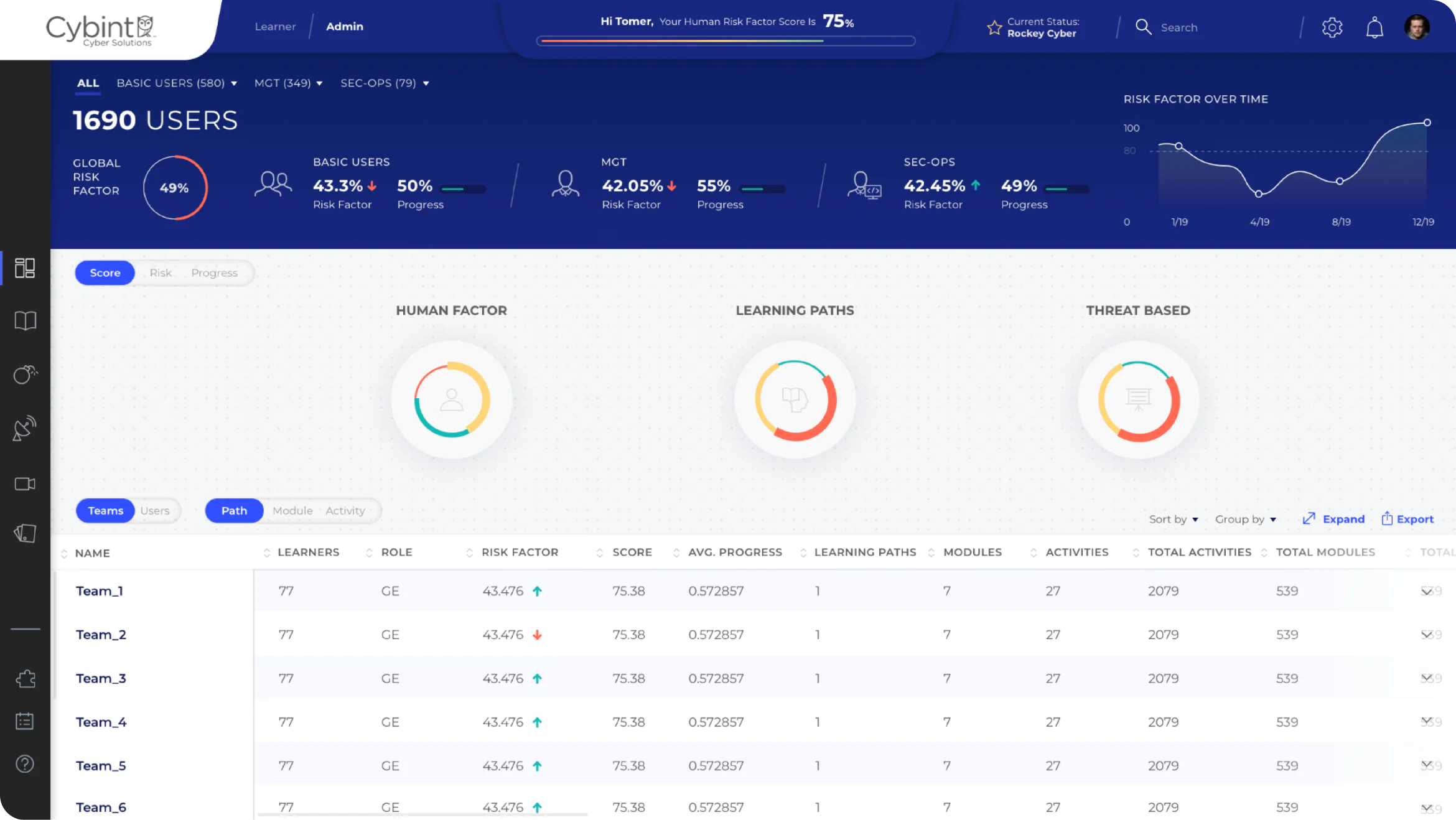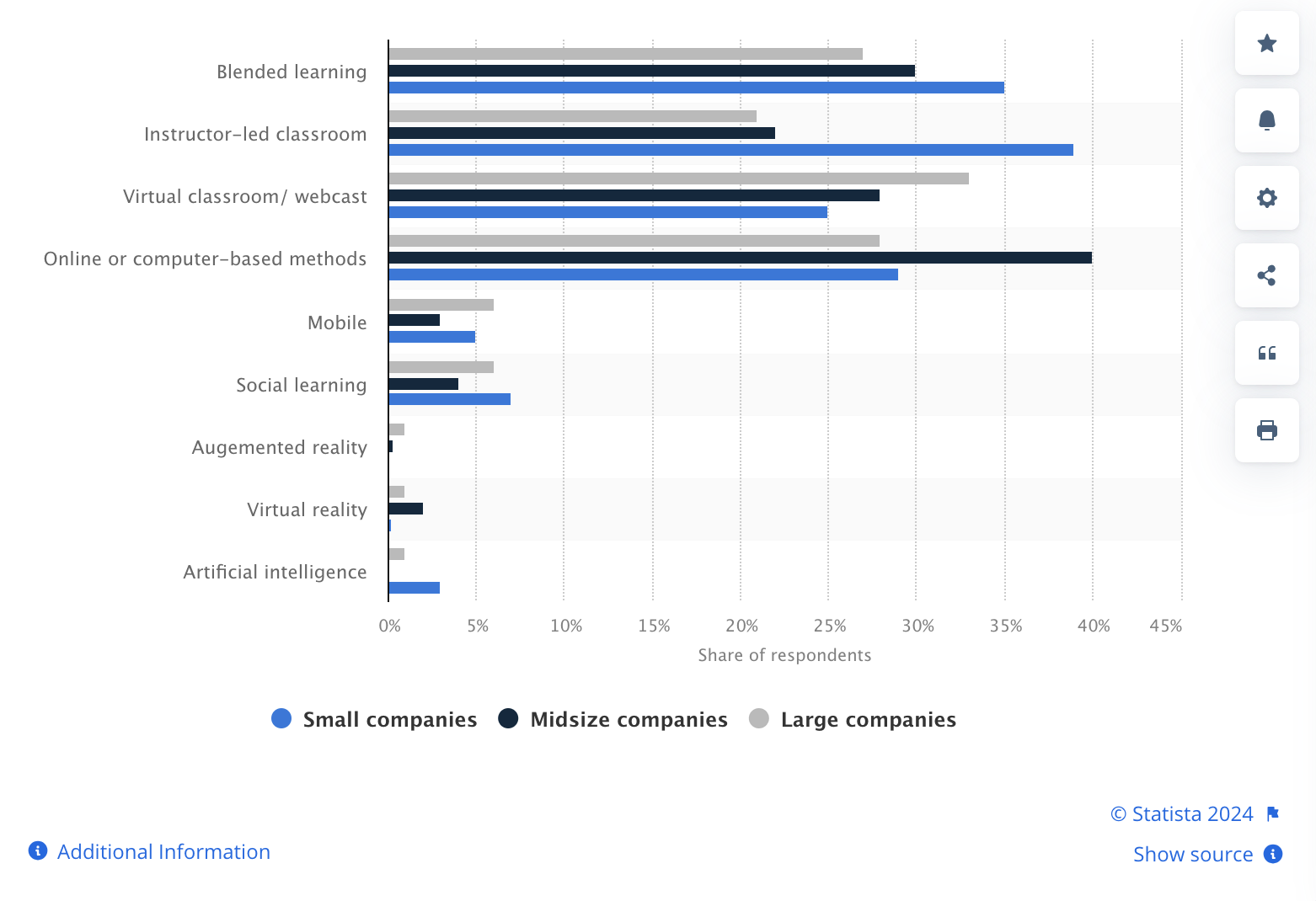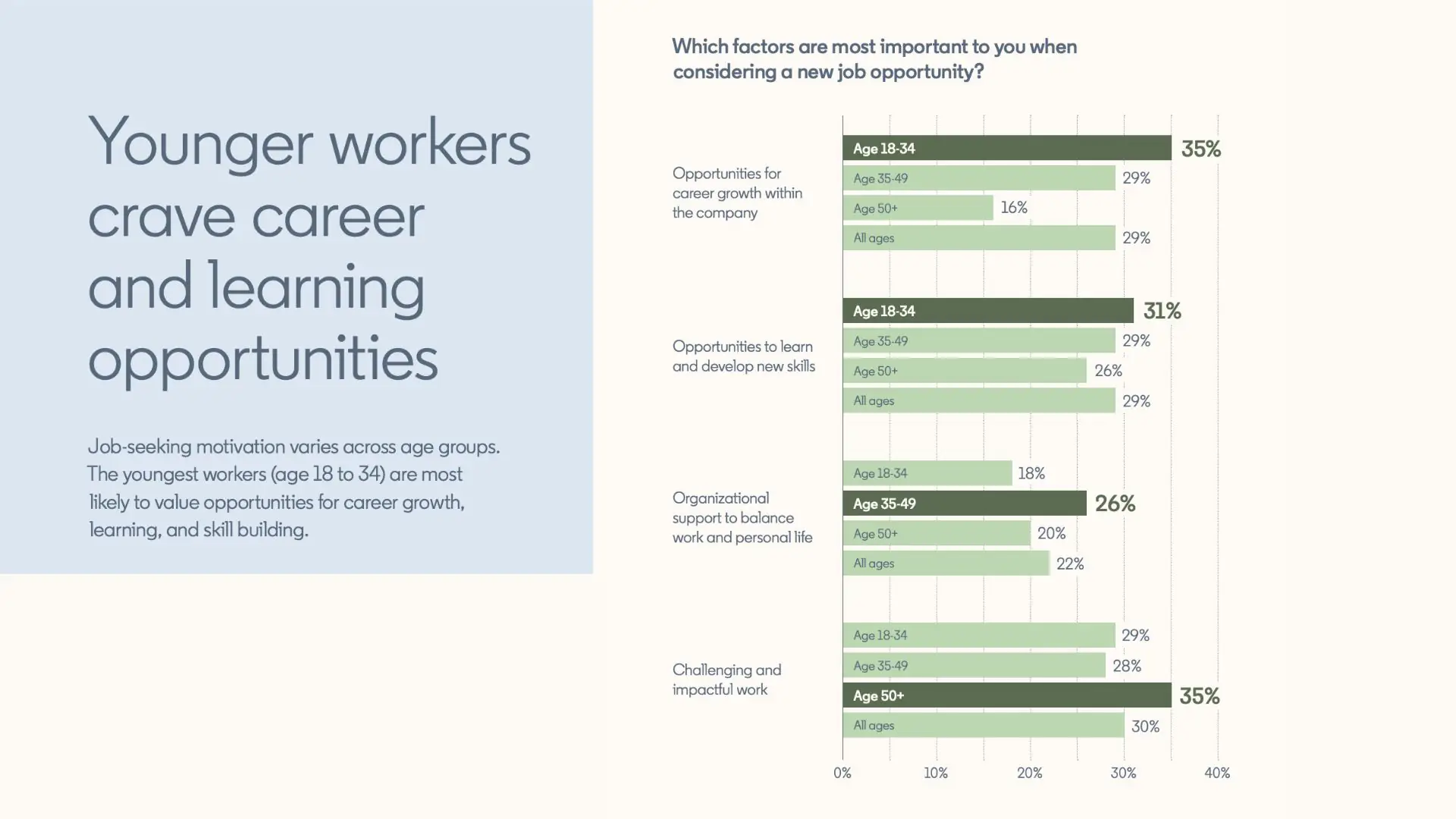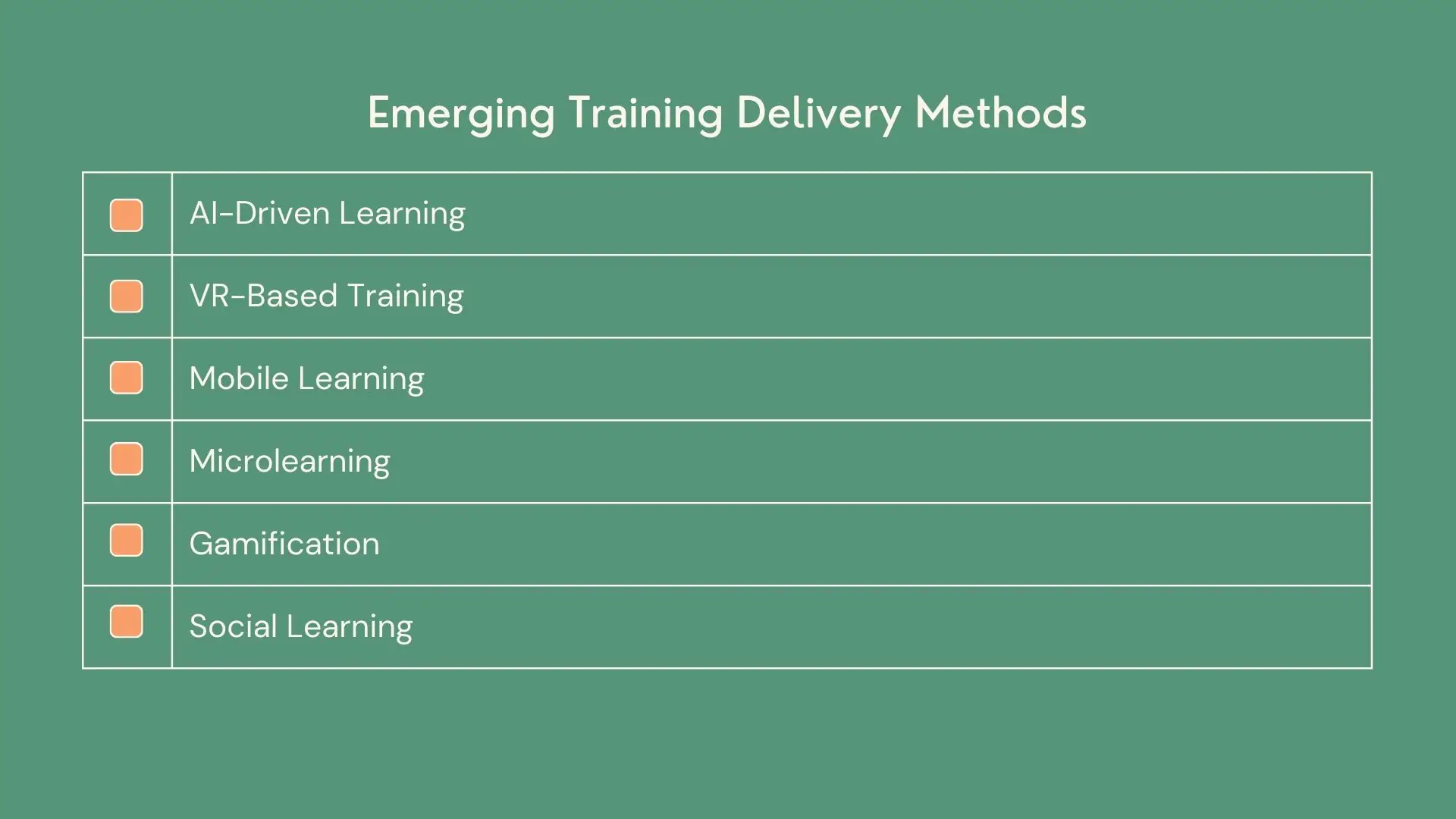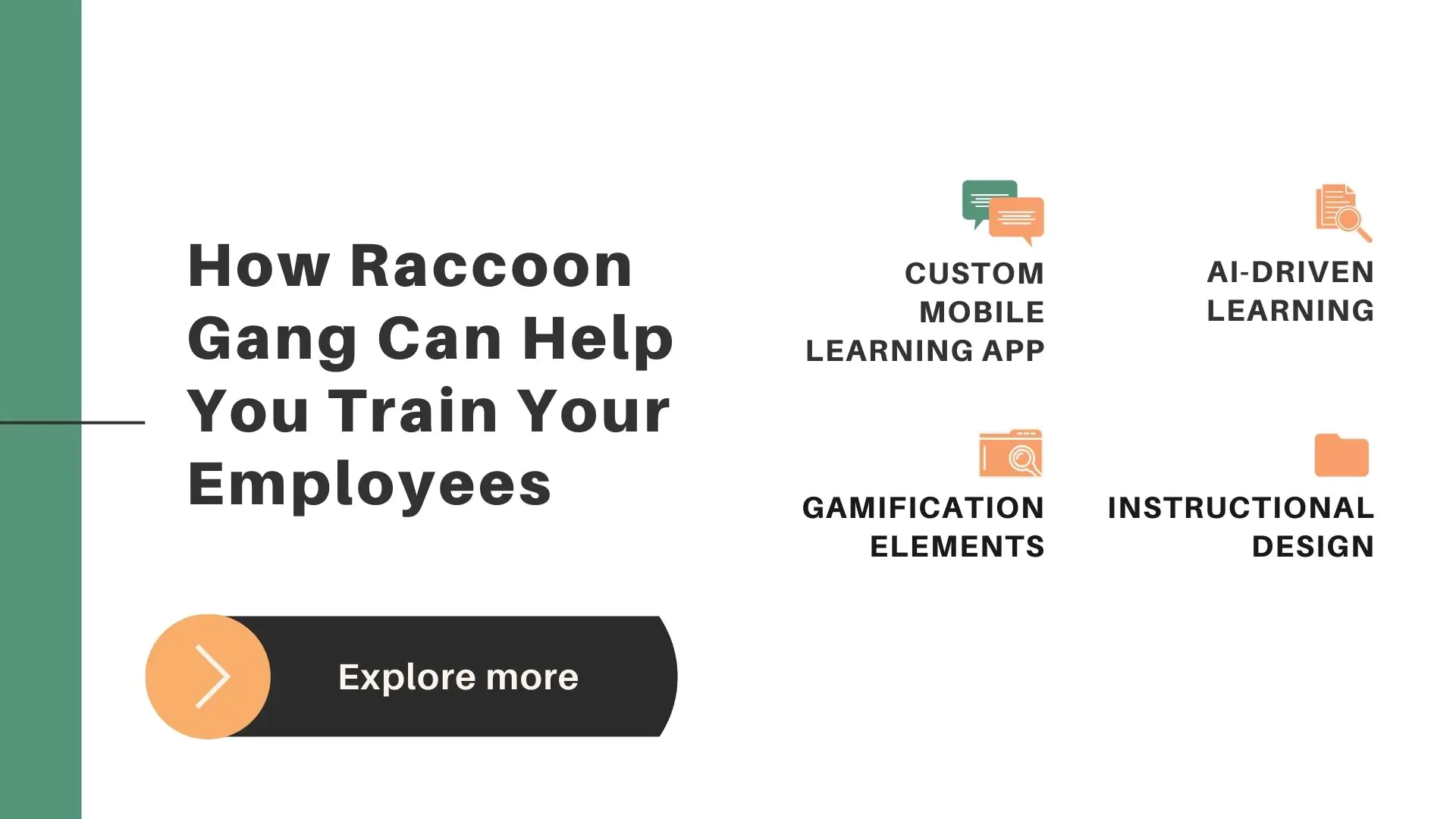Today, companies and organizations increasingly feel that outdated training methods no longer work as well as they once did. At the same time, we understand that choosing the right types of training delivery methods contributes to the growth of productivity and keeps the company’s happiness index at a high level (did you know a happy employee is 31% more productive than an unhappy one?), and prepares the workforce for future challenges.
L&D professionals and business owners need ways to train their teams while saving money and keeping employees motivated and engaged. Nowadays offers training delivery methods that help in staying ahead of the competition and growing your business. Delivery methods evolve based on trends in corporate training, which we explore separately.
Evidence snapshot (2025):
1) Blended designs often show positive effects when aligned with goals and feedback.
2) Tech access ≠ automatic gains; design and context matter.
3) Aim for WCAG 2.2 for mobile/desktop delivery.
This is why looking at the newest training methods is so important as we move into 2025 and beyond.
In this article, we’ll explore key insights into the main training strategies:
- Discover which training delivery methods have proven effective so far.
- Learn what to prioritize when choosing a training method.
- Understand the pros and cons of the latest approaches.
- See how various industries have successfully implemented new training methods.
- Equip your business with suitable tools and strategies for 2025.
“In our work, we come across various training methods used by our customers. It is worth noting that all of them work well if they are chosen with an eye on the needs and goals that you have set for the company.”
As the case of one of our customers shows, creating a high-trust, high-performance culture for all employees became possible thanks to a custom training platform that supports various content types: video, text, PDF, Google Docs, SCORM, LTI, iFrame, and more.
To understand which of the methods will suit you best, let’s dive into what’s shaping the future of training delivery.
Snapshot of 2024: Effective Training Delivery Methods
In 2024, businesses continue to implement various possible training delivery methods for their workforce. The most common method of delivering training at all levels in an organization is e-learning.
The method owes its popularity to cost-effectiveness and flexibility. As we can see from recent reports, over 40% of Fortune 500 companies now rely on eLearning platforms to consistently train and enhance the skills of their employees.
However, do not ignore other modern training delivery methods. They have strong positions among learners. Blended learning combines online courses with face-to-face instruction. Combining the best of both, the method shows an impressive 82% of learners who prefer blended teaching to classic teaching environments.
Virtual instructor-led training (VILT) is another rising trend. In North America, 64% of L&D departments use VILT. Live, interactive training sessions are presented to employees as a practical solution in the era of remote work.
“Training delivery methods that are most often chosen today lead us to believe that organizations are shifting toward more flexible, scalable, and engaging solutions that fit the demands of today’s workforce.”
When we talk about 2025, it is safe to say that these training methods will still be common. We’ll likely see AI make e-learning platforms more personalized. Employees will benefit from content that becomes increasingly relevant to each learning pace.
Blended learning will strengthen its position as virtual and in-person components integrate with more advanced tracking and reporting tools. Meanwhile, VILT will give employees hands-on training experiences without extra physical resources. The further growth of virtual reality (VR) and augmented reality (AR) will be an important stimulus for such changes.
But if you predict not the training method but its direction, then 59% of L&D experts agree that learning tools that support employee career development will win by 2026, and 49% believe in skills-based learning.
Choosing the Right Training Delivery Method: What Really Matters
Choosing the right types of training delivery methods starts with nothing else but understanding your audience. It is no secret that different generations learn in different ways. Just remember the difference between the older generation and yourself. Millennials prefer structured, guided learning. Isn’t it? Meanwhile, Gen Z favors quick, self-paced content.
As another of our articles notes, “Gen Z learners are digital natives who seek quick, bite-sized learning that’s interactive and mobile-friendly.”
Knowing these preferences is key to engaging both groups effectively. You should also not forget about Gen A, who will soon be part of the workforce, including yours.
Here are three other important factors when selecting delivery methods for training:
Workforce Composition (In-house vs. Remote)
In-house teams may benefit from face-to-face or blended learning, which encourages direct interaction. Remote teams, however, are better suited for e-learning or virtual instructor-led training (VILT). These methods provide flexibility and access from anywhere.
Technology
Your company’s tech setup matters. Why is mobile learning so popular? Each of us has a smartphone. That’s all. If employees have reliable devices and internet, use the advantages of these tools. Because when it comes to training, engagement is everything. Mobile learning as part of a blended approach or e-learning process can become a secret ingredient for the success of your L&D initiatives.
Budget
The budget always has the final say in the selection. E-learning is often cost-effective and easy to scale. Solutions like VR offer immersive experiences and, at the same time, demand a higher cost. Blended learning instead strikes a balance between digital and in-person instruction.
Ignoring these factors—audience, workforce, technology, and budget—will not help you choose the right training method.
Exploring the Pros & Cons of Emerging Training Delivery Methods
Among companies seeking to improve their training strategies, several eLearning delivery methods are gaining popularity. Let’s look at some of the most promising methods. Who knows, maybe one of these methods will benefit your organization.
VR-Based Training
VR-based training provides immersive, hands-on learning experiences. This method is the best option for certain industries, namely healthcare, engineering, and manufacturing, in which practical skills receive the highest priority.
Mobile Learning
Mobile learning, as you can already see, confidently occupies a place in the hearts and minds of modern learners. It’s perfect for remote workers or those who frequently move. On average, a person receives 46 notifications on their smartphone during the day. How many of them are really useful?
As seen in a recent project, “The customer needed a mobile app (iOS and Android) because 80% of their learners regularly used mobile devices and tablets.” This approach led to increased participation rates and improved course completion. You can expect to increase completion rates by an average of 50% with a mobile learning application. This is a hard fact to ignore.
AI-Driven Learning
AI-driven learning is gaining momentum thanks to an ever-widening list of options for using AI-based tools. From the initial creation of educational content to the personalization of the materials of the entire course, this method offers the most learner-centric approach to acquiring new skills by your specialists.
88% of surveyed organizations report that personalized learning has positively impacted their strategic goals.
Microlearning
Microlearning is becoming a lifesaver for modern learners. It doesn’t matter if you’re learning a foreign language or taking advanced training courses; short, focused lessons are the best fit for busy schedules.
Employees spend just 24 minutes per week on average focused on training and development.
Gamification
Game-like elements—such as points, badges, and leaderboards become an essential part of training programs when it comes to choosing training platforms. As we mentioned earlier, engagement is a must-have for the success of training initiatives, particularly for younger employees.
Gamification in training leads to a 60% increase in learner engagement.
Social Learning
In the era of remote working, collaboration, where employees learn from one another through discussion and shared experiences, contributes to building a community that is truly interested in progress.
Comparison Table: Pros & Cons of Emerging Methods
| Training Method | Pros | Cons |
| VR-Based Training | Immersive, hands-on learning; highly engaging | High cost of setup and equipment |
| Mobile Learning | Flexible, accessible anywhere, anytime | May not work for all types of training |
| AI-Driven Learning | Personalized learning paths; data-driven insights | Requires advanced tech infrastructure |
| Microlearning | Quick, digestible content; fits busy schedules | May lack depth for complex topics |
| Gamification | Increases engagement and motivation | Can be distracting if not implemented properly |
| Social Learning | Encourages collaboration and knowledge sharing | Requires active participation from employees |
“Each of these eLearning delivery methods has advantages for your training initiatives and employee performance. Of course, the list of methods can change, and the methods themselves can develop, but one thing can be said for sure: We will not get anywhere from a learner-centric approach if we want to get the maximum impact from our workforce.”
Success Stories of Training Implementations Across Industries
Let’s take a look at how companies from different sectors have successfully transformed their training strategies and how the right training delivery methods can drive meaningful results.
Case Example 1: A Technology Company Moving from Classroom-Based to Blended Learning
Consider a tech company that relies on classroom-based training. Dropping engagement levels stimulates the company to try a blended learning approach. For the company, this meant providing learners with access to online courses and attending occasional in-person workshops. Employees received the flexibility of online learning but with just enough face-to-face time to remind them that humans still exist!
As a result, the company could see up to a 30% increase in employee engagement with appropriate training software.
Case Example 2: A Healthcare Provider Using AI-Driven Learning to Upskill Staff in Real-Time
Imagine a healthcare provider needing to quickly upskill medical staff due to frequent changes in industry guidelines. Adopting AI-driven learning delivers personalized, real-time training based on individual knowledge gaps. In healthcare, such gaps have a very high price for patients. And we are not talking about money now.
Important. AI-based tools can tailor content to each employee, potentially reducing training time by 40%. Staff would focus on learning critical information while staying current with medical protocols.
Case Example 3: An Enterprise Adopting VR for Safety Training
Imagine an industrial company dealing with high-risk work environments. VR-based training has been implemented to improve safety training. Employees can practice handling hazardous situations in a safe virtual environment without risking their health.
Impact. The company could experience a measurable decrease in on-site accidents as employees gain confidence and skills through immersive, hands-on training. Investing in this type of training might lead to better safety outcomes and fewer workplace incidents. In this case, even a minimal reduction in accidents will mean a huge success.
Conclusion: Preparing for the Future
As we’ve discussed, selecting the right training delivery methods can significantly impact your industry and workforce needs. Whether it’s blended learning for tech companies aiming to boost engagement or VR-based training for sectors where safety is crucial, there’s no universal solution. An LMS for customer onboarding can also play a vital role, simplifying the process and ensuring new clients understand your product or service effectively. The key is to choose the approach that aligns with your objectives and empowers your employees to excel.
Looking ahead, trends like AI-driven learning are set to transform training further, providing personalized learning paths that adjust in real-time. When you compare delivery formats, factor in AI in L&D so you match automation with the right training methods.
Picture your employees receiving precisely the content they require, exactly when they need it, with minimal effort on your part. Additionally, gamification—integrating game-like features into training—enhances engagement and makes the process enjoyable, motivating employees to remain committed.
Moreover, social learning networks enable your team to learn collaboratively, share ideas, and tackle challenges together. These strategies will define the future of training by emphasizing personalization, engagement, and teamwork.
Companies that proactively plan their training delivery methods will be the frontrunners in the years to come. If you want your workforce to remain competitive, it’s essential to start re-evaluating your training strategy now.

